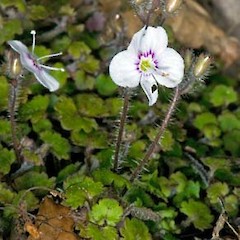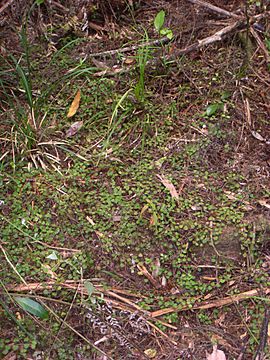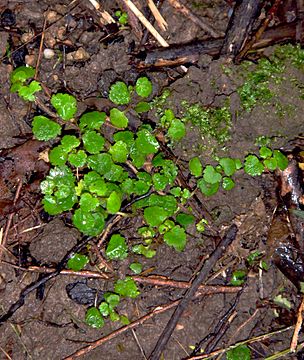Riverhead speedwell facts for kids
Quick facts for kids Riverhead speedwell |
|
|---|---|
 |
|
| Conservation status | |
 Nationally Critical (NZ TCS) |
|
| Scientific classification | |
| Synonyms | |
|
Veronica jovellanoides, also known as Riverhead speedwell, is a special flowering plant. It is very rare and found only in New Zealand. This plant is currently known to grow only in the Ernest Morgan Reserve, a forest near Auckland. It was first discovered there by chance in 2007.
This plant grows like a mat on the ground. It starts to flower in spring, showing pretty white flowers. Later, it produces small brown seeds that the wind carries away.
Contents
What Does Riverhead Speedwell Look Like?
Veronica jovellanoides is a plant that spreads out, forming a mat up to 2 to 3 meters wide. It has long, reddish-brown stems that are covered in tiny hairs. Even though it can cover a large area, it stays very low to the ground, only about 5 centimeters tall.
Leaves and Flowers
Its leaves are shaped like small spatulas, about 4.5 to 12 millimeters long. They are green on top and a lighter green underneath. The edges of the leaves are a bit reddish, and they hang from very hairy stalks that are 2 to 10 millimeters long. The leaves themselves are also hairy and have three to five pairs of small teeth on each side.
The plant flowers from October to December. Its white flowers have four petals and a purple ring around the center. Each flower is about 10 to 12 millimeters wide, and its center is a yellow-green color.
Seeds and Fruiting
After flowering, the plant produces fruit from December to February. These fruits contain pale brown seeds, which are about 1.2 to 1.8 millimeters long and 1 to 1.4 millimeters wide. When these seed capsules get wet, they split open to release the flat seeds.
How Was Riverhead Speedwell Discovered?
This unique plant was found in November 2007. A local plant nursery owner named Geoff Davidson was walking in the Ernest Morgan Reserve with Sharon Graham, a field officer. Geoff first thought it was a different plant called Jovellana repens. However, he was confused because that plant usually doesn't grow in this area. So, he took a small piece of it to grow at his nursery.
Identifying the New Species
Later, a New Zealand botanist named Peter de Lange thought it might be a type of Veronica. This idea was proven correct when the plant flowered. Phil Garnock-Jones, another expert in New Zealand plants, suggested it was a completely new species. These two botanists, along with Geoff Davidson, shared their discovery in a science journal in 2009.
The "Bamboozle" Nickname
Botanists gave Veronica jovellanoides the nickname "Bamboozle." This is because it was so hard to find again after its first discovery! After it was found, four people searched the reserve for 80 hours but still couldn't locate it. Finally, 40 members of the Auckland Botanical Society walked together in a line and managed to spot just one patch of it.
What Do the Names Mean?
The name Veronica comes from Saint Veronica. The word itself means "Bearer of victory."
The second part of the plant's scientific name, jovellanoides, means "similar to Jovellana repens." This is because it was first mistaken for that plant.
The common name, Riverhead speedwell, comes from the Riverhead Pine Plantation. This popular recreation spot for people from Auckland is located just north of where the plant was found.
Where Does Riverhead Speedwell Live?
Veronica jovellanoides is found only in New Zealand. As of 2009, it grows only in the Ernest Morgan Reserve, which is northwest of Auckland on the upper North Island. This reserve is 20 hectares (about 50 acres) in size.
Its Special Home
There are only three known plants of Veronica jovellanoides in the wild. They all grow in a small area of about 6 square meters. They like shaded and damp ground, growing among ferns, mosses, and liverworts.
The reserve itself has the Ararimu Stream running through its southern side. Long ago, Māori used this stream as a shortcut between the Waitemata and Kaipara Harbours. The forest in the reserve is mostly made up of large trees like kauri and tanekaha, with rimu and kahikatea trees in the lower areas.
Can Riverhead Speedwell Be Grown?
Yes, Veronica jovellanoides is quite easy to grow from pieces that have roots or from stem cuttings. When they are flowering, they are very attractive plants.
However, plants grown in Wellington have been found to easily get a plant disease called powdery mildew. This problem has not been seen in plants grown in Auckland.
Images for kids




